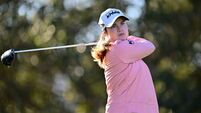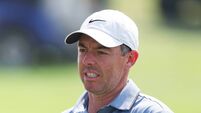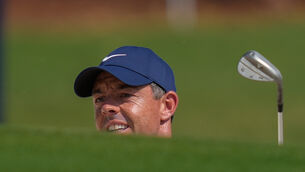Harry’s game
He learned early in life that the only difference between realising a dream and losing oneself in fantasy was back-breaking work. Hour upon hour was spent learning the secrets of every stick in his bag, mentally rehearsing every on-course scenario.
Throughout the history of the sport to this point, golfers had been holding the shaft of the club like a baseball bat. On his own, Harry had come up with an innovative overlapping grip that locked his powerful hands into a single unit, delivering a harder, surer strike. The ball obeyed him like a circus animal; fades and draws appeared on command and his standard shot flew straighter than bullets. All this with just eight clubs in his bag.
Vardon drafted many innovations into his game. He moved the ball forward in his stance, squared his feet to it, stood upright and made a powerful, efficient athletic swing that wouldn't look out of place among today's professionals.
His demeanour and methods on the course appeared so deceptively effortless fellow pros began to call him 'The Stylist'.
By the turn of the century, Vardon had clocked up three Open victories and had one run of 14 straight tournament victories, a streak never since repeated, and his reputation was such that he was offered $2,000, a vast sum, to tour America for nine months and spread the gospel of golf.
One gig required of him during the visit was to hit balls into a net in a Boston store and among the hundreds of people who turned up that day was seven-year-old Francis Ouimet. As he watched Vardon's club carve the same flawless arc through the air, he decided that he wanted nothing more from life than to emulate this stylist.
Coincidentally, Vardon's great rival JH Taylor, who in 1900 had matched his three Open victories, also travelled to America that year and on one stop he played a 36-hole exhibition at Brookline, across the road from Ouimet's home. Francis watched every shot and added Taylor's to the bank of golf swings he was memorising.
But it was Vardon who had cemented his reputation as the best golfer in the world and as the godfather of American golf. He had single handedly created the first great wave of American interest in the game and when he unknowingly awakened the ambitions of seven-year-old Francis Ouimet in Boston, he unwittingly set in motion events that would produce its second, even more explosive expansion.
At age nine, Ouimet was the proud owner of three clubs, his brother Wilfred's driver, a cut down brassie (a fairway two wood so called because of its brass sole plate), and a mashie (equivalent to the modern five iron) thanks to a deal with a Boston store which traded used balls for clubs. Unwittingly, he'd learned the game in the right sequence tee to green.
Now caddying at Brookline, he struck up a relationship with the club pro Willie Campbell, who gave him four new clubs. He applied himself to the study of their use with considerable devotion.
The following year he bested Wilfred for the first time, and at 13 he was asked by a member to play a round with him and shot an 84. Caddies were not allowed play the course, but everyone realised Ouimet had the ability to go to the top and the rule was overlooked in his case from then on.
In 1910, he missed the cut for the US Amateur Open played at Brookline by a stroke and repeated the dose the following two years.
In 1913 he told his then boss George Wright that "this is the year I have to win the National Amateur" but at Garden City, Long Island, he was beaten to the title by Jerry Travers in the final match.
One door closes and another opens, the old adage has it, and so it was for Ouimet. His performance in the Amateur had not gone unnoticed and the President of the USGA Robert Watson vowed to get him to play in the US Open, which that year was to be played at ... The Country Club, Brookline, Massachusetts.
In the time following his last visit to America, Harry Vardon had been through the wringer. Having contracted tuberculosis, he not only had to fight for his career, but his life. Vardon conquered the disease, but it left him with a terrible shake in his right hand and a case of the dreaded 'yips'.
Nevertheless, he fought the problem and won the Opens of 1903 and 1911 to bring his total number of championships to five and in 1913 he returned to America for another promotional tour and another shot at the US Open title he won back in 1900.
He was accompanied by his great rival Ted Ray and the duo were among the favourites, but the Americans were hot on the chances of National Amateur winner Travers and the reigning US Open champion, Johnny McDermott. Nobody reckoned on the chances of Francis Ouimet.
THE 18th US Open featured 168 players, 145 professionals and 23 amateurs, and Vardon predicted four rounds of 75 should win the title. Back then the players had to play 36 holes to qualify and having done that, then played 36 holes on the Thursday and Friday in the Open proper.
Ouimet had worries other than what score might win the title. His regular caddy ditched him on the eve of the tournament and he had to resort to booking 10-year-old Eddie Lowery, who had caddied for him before. But Eddie's mother did not know her son's intentions and neither did his school truant officer.
On the first day of the competition, Vardon drew a gallery of 5,000. Ouimet's match with Jim Barnes drew none. That was about to change however. Vardon shot a 75 and appeared to be leading comfortably the first qualifying group, of which Ouimet was also part. Ouimet stunned everyone, including himself, with a 74 and everyone suddenly wanted to know who the local guy was.
In the second round that afternoon Ouimet was dismayed to be playing in front of a gallery almost a thousand strong, including US President Howard William Taft.
He carded a nervy 78 to Vardon's 76 to trail by one after 36 holes. But he was comfortably into the main field.
On the Thursday morning, he started double bogey, double bogey, bogey and the adventure was beginning to fall apart. Ten-year-old Lowery reached into his limited catalogue of life experience to find the right advice.
"Okay, we just gotta settle down now, Francis," he said. "What are we going to do to turn this around?"
Francis looked at Eddie and smiled. "I guess I'm just going to have to play better," he replied.
"That'd be a good place to start," the young man responded.
He got it together and carded a 77, six strokes off the lead but still in the hunt.
He then shot 74 that afternoon and ended the day tied for fifth with Walter Hagen, among others. Vardon was tied for first and Francis was four shots adrift.
A gallery of over 3.000 was on hand to watch Ouimet on the final morning. It was hardly surprising so many followed the unknown guy. The two Englishmen, Vardon and Ray, looked invincible and most of the leading Americans had faded. Ouimet was now the Americans' main hope. His mother sat on the porch of 246 Clyde St., across the road from the 17th and said rosaries.
EDDIE LOWERY dreamt Ouimet would shoot a 72 during the tournament and told him so. Francis was not so sure, but went out in damp conditions that Friday morning and carded a 74. Ted Ray shot 76 and Vardon 78. The three were level on 225 with 18 holes left.
Vardon and Ray did not cover themselves in glory over the final 18. They both shot 79 to tie on a total of 304 but, as Vardon opined afterwards: "It was a game effort, but I'm afraid we have no hope now".
Nevertheless, they were in the lead in the clubhouse and all the American pros were falling by the wayside and astonishingly Ouimet was the only home hope left. By now he was having to fight his way through the galleries to get to each shot.
He was going strong though and on the fifth tee the news filtered through that he had a five shot lead to win the US Open. But nerves set in and by the seventh; the lead was down to two. He dropped another two on the eighth. All square.
Francis parred the ninth but another double bogey on the 10th put him two shots adrift with eight to play. The spectating Ray and Vardon retired to a drinks tent convinced they were looking at a play-off between themselves.
"Keep your head down Francis, I'll watch the ball." It had been Eddie's mantra since the start. It worked on the 11th when Ouimet regained his composure and parred the hole.
"Seven holes left to make up two strokes. I figure our best chances are here, at 12 and at 16," said Francis. "Let's get one," said Eddie.
He didn't and the crowd sensed the prize drifting away from him and they, in turn, started drifting away too. But Ouimet rose to the occasion and he got a stroke back on the 13th with a miraculous chip in and the roar from the crowd reached his praying mother, frightening the life out of her. One stroke down, four to play. Frances had jolted the crowd back to life.
He made a nine-foot par putt on the 16th and the crowd was now half mad with tension and Mary Ouimet could bear it not longer on the porch and rushed across the road to witness the denouement.
There were 20,000 now following his match and when he sank a birdie putt on 17 the roar could be heard two miles away in downtown Brookline. One hole left and a three to win, a four to tie.
"Keep your eye on the ball and hit it," said Eddie. Francis obliged. His second landed on the damp fringe and he had a putt through a few inches of spiked collar and then at least two breaks before it reached the hole. He hit it harder than he intended and missed the hole by an inch and went five feet past. He holed the putt back to tie and an admiring Ray commented: "That was the best demonstration of skill and nerve I've ever seen in golf." A play-off beckoned.
Eddie's premonition that his man would shoot a 72 came to pass the following day in front of the biggest galleries ever seen at an American tournament. Ray shot a 78 to finish third and Vardon a 77 for second. Ouimet shot 72 for the win.
It was the greatest game ever played and Ouimet beat the man who, to that point, was the greatest who ever played it.
The Greatest Game Ever Played, by Mark Frost, Little Brown, Price Stg17.99.















